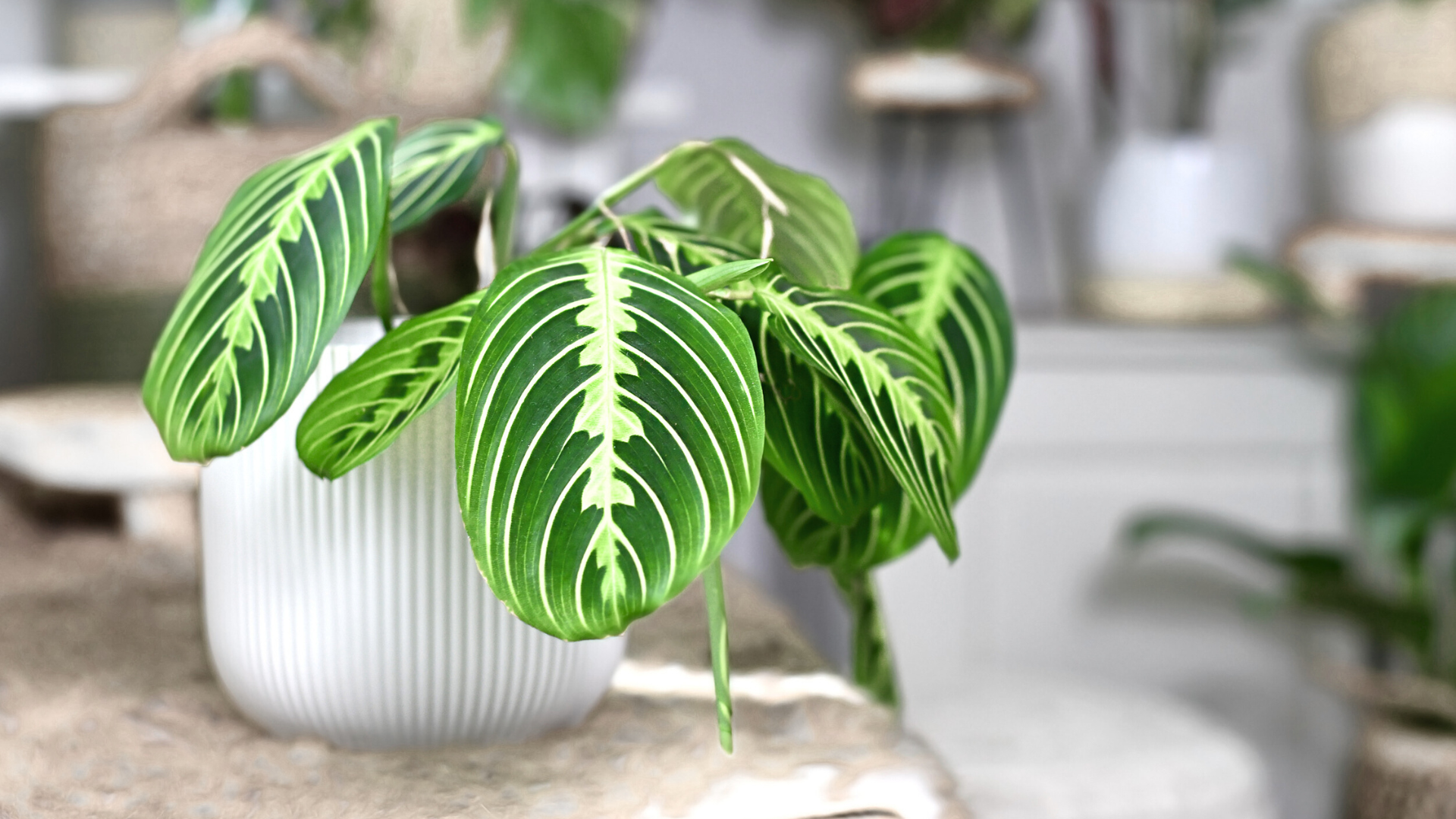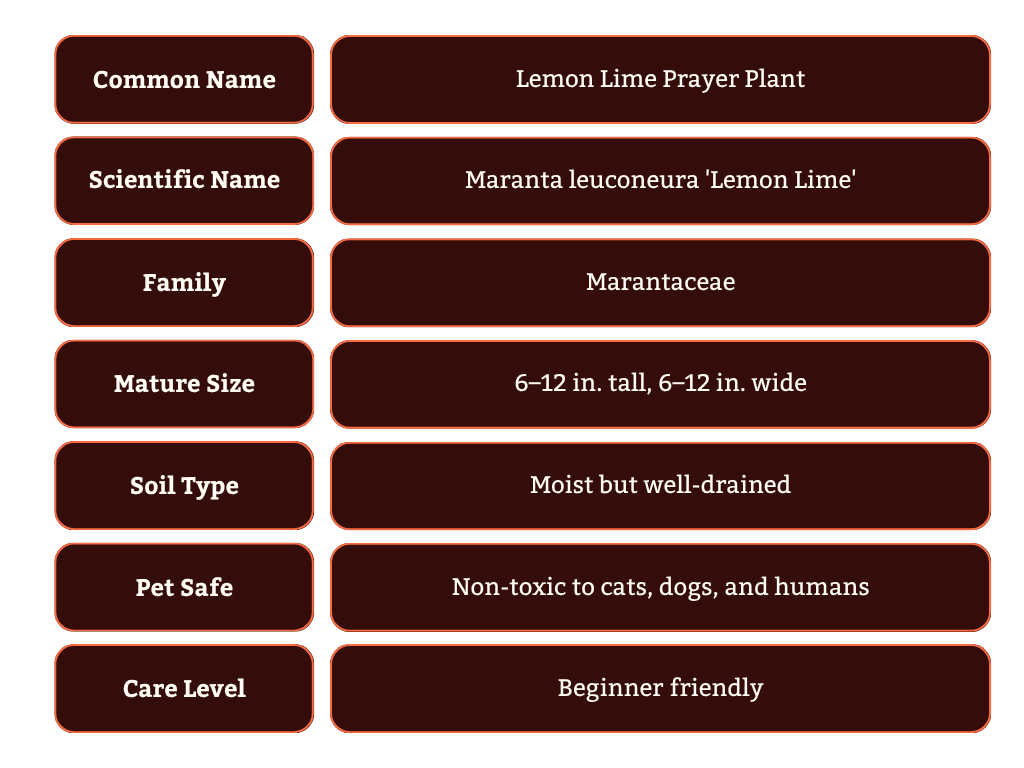Lemon Lime Prayer Plant Care Guide
Your complete guide to nurturing a thriving Lemon Lime Prayer Plant
Your Plant's Story
This stunning Lemon Lime Prayer Plant started its journey as a cutting from one of our cherished mother plants in our greenhouse. Each plant carries the vibrant genetics and uplifting energy of its parent, carefully propagated and nurtured until ready for its new home.
The Magic: This radiant plant actually "sleeps" just like its red cousin - its leaves fold up at night like praying hands, then open again each morning. However, this beauty brings something extra special with its bright lemon-lime coloring, which seems to glow with the energy of sunshine!
From Brazilian rainforest to your space: Your lemon lime prayer plant's ancestors evolved in the dappled light of the forest floor, developing their unique daily leaf movement called nyctinasty - a fascinating dance with light that happens as part of their natural circadian rhythm.
Hand-selected for you: Every dirt witch lemon lime prayer plant is chosen for its vibrant chartreuse patterns, healthy root system, and that special sunny energy that makes them perfect mood-lifters in any home.
At a glance
Pet Safe
Non-toxic to cats and dogs - safe for furry family members
Bright Indirect Light
Loves bright spots but hates direct sun - think cozy reading nook lighting
Beginner-Friendly
Perfect for new plant parents wanting something stunning but forgiving
Plant Overview
Essential Care
Light
Perfect placement: Bright, indirect light - imagine that perfect spot where morning sunlight feels gentle and welcoming
Best spot: North or east-facing window, or several feet back from a south window
Avoid: Direct sun (will fade those beautiful lemon-lime patterns that took so much energy to create!)
Low light tolerance: More forgiving than many plants, but needs at least some bright light daily
Too much light signs: Faded colors, brown crispy patches on those gorgeous leaves
Watering
Finding the rhythm: Your lemon lime prayer plant will teach you to tune into its needs - water when the top 1-2 inches of soil feel dry to touch
Spring/Summer: Every 1-2 weeks (more when the sunny energy is high)
Fall/Winter: Every 2 weeks, as both you and your plant settle into a more restful pace
Pro tip: Use filtered or distilled water - these sensitive souls can be particular about tap water chemicals, just like many of us prefer clean water
Signs it needs water: Soil feels dry halfway down, leaves may start to look less perky
Signs of overwatering: Yellow leaves, mushy stems, that telltale musty soil smell
Humidity
Prayer plants are humidity lovers at heart! These tropical beauties truly thrive in humid environments - think of their natural rainforest home. While they'll tolerate average household humidity, they'll absolutely flourish when you give them that extra moisture they crave.
Creating the vibe: Moderate to high humidity - like that perfect spring morning feeling in the air
Easy ways to boost humidity:
Place on a pebble tray with water (creates a mini tropical microclimate)
Group with other plant friends (they support each other's humidity needs)
Use a humidifier nearby (your skin will love this too!)
Avoid: Misting the leaves directly (can invite fungal visitors to the party)
Temperature
Comfort zone: 60-80°F (nice and cozy, just like you like it!)
Avoid: Cold drafts, heating vents, A/C units, anything below 60°F
Winter care: Keep away from cold windows but maintain bright light
Soil & Feeding
Soil: Well-draining potting mix (standard houseplant soil works beautifully)
Feeding schedule:
Growing season (Spring/Summer): Every 2-4 weeks with diluted liquid houseplant fertilizer
Dormant season (Fall/Winter): Monthly feeding, or pause altogether
Fertilizer type: Balanced liquid fertilizer diluted to half strength
Pro tip: A tablespoon of coffee grounds monthly can help maintain that slightly acidic soil they love
Monthly Care Ritual
Every month, create a moment to connect with your plant:
Check soil moisture and water as needed (perfect time to appreciate those stunning patterns)
Inspect leaves for pests - turn this into a mindful observation of their beautiful markings
Gently wipe leaves clean with damp cloth (they'll respond with even brighter, more vibrant colors)
Rotate pot 1/4 turn for even growth (like turning toward the light in your own life)
Remove any spent leaves that have completed their journey
Check humidity levels - adjust as needed for both plant and personal comfort
Growing season bonus ritual (Spring/Summer):
Offer diluted liquid fertilizer as nourishment
Consider light pruning to encourage fuller, more confident growth
Check if repotting is needed (every 2-3 years - these slow growers aren't in a rush)
Propagation & Repotting Magic
When Your Plant Needs More Space
Every 2-3 years in spring or when your plant starts sending you these signals:
Roots are peeking out drainage holes like they're waving hello
Water rushes straight through without the soil getting a drink
Your plant has simply outgrown its current home and is ready to spread
Think of repotting as giving your plant room to breathe and expand - just like we all need sometimes.
The Magic of Making More Plants
Best method: Division during repotting (it's like helping a family expand!)
There's something absolutely magical about taking one thriving plant and creating multiple new lives from it. Here's how to work this green magic:
Gently separate root clumps with your hands - use your intuition and let the plant guide where it wants to divide
Each new baby needs its own roots and several stems - they're like little individuals ready for their own journey
Plant in similar soil mix - keep that familiar foundation they're used to
Keep warm and humid until established - like nurturing new life, they need extra care as they find their footing
Pro tip from one plant obsessed person to another: These make incredible gifts! There's something special about sharing a piece of your thriving plant with someone who needs a little sunshine in their life. Watching your plant's babies bring joy to other homes creates its own kind of magic.
Common Visitors & How to Handle Them
-
The tiny energy drainers: These microscopic visitors show up when the air gets too dry - they're basically telling you that both you and your plant need more moisture.
Signs: Tiny webs on leaves, stippled/dusty appearance, tiny moving red/brown dots Natural remedy: Increase humidity immediately (win-win!), wipe leaves with damp cloth, spray with neem oil.
-
The white cotton crashers: These little cotton-ball lookalikes love to hide in cozy leaf joints - they're drawn to stressed plants.
Signs: White cotton-like clusters in leaf joints and stems
Gentle removal: Dab with rubbing alcohol on cotton swab (they dissolve instantly), or use insecticidal soap spray
-
The moisture lovers: These tiny flies are actually telling you something important about your watering rhythm - they appear when soil stays too wet.
Signs: Tiny flies buzzing around soil surface (more annoying than harmful)
Rebalancing: Let soil dry more between waterings, use yellow sticky traps, top-dress with sand to break their cycle
FAQ & Plant Wisdom
-
Yellow leaves are your plant's way of communicating about its care needs! Usually it's about finding the right balance - check if the soil feels soggy (too much love) or if it's not getting enough bright light. These plants need at least some indirect sunshine daily to maintain their vibrant energy.
Remember, occasional yellowing of older bottom leaves is perfectly natural as they complete their life cycle.
-
This is your plant asking for more moisture in the air - think of it as craving that tropical spa atmosphere it evolved in. Lemon lime prayer plants thrive in moderate to high humidity.
Try a pebble tray, humidifier, or grouping with other tropical plants. Also check that it's not getting any direct sun, which can cause crispy brown patches.
-
Your plant is speaking to you through its posture.
Start by checking the soil with your finger - dry soil means it's thirsty, soggy soil suggests you've been too generous with water. Also, scan for tiny visitors under the leaves and make sure it's not near heat sources or cold drafts that might be stressing it out.
-
Faded colors usually mean the light isn't quite right. Too much direct sun will bleach those gorgeous green veins, while too little light leaves them looking dull. Find that sweet spot of bright, indirect light.
During growing season, monthly feeding helps support those energy-rich colors.
-
Don't worry - your plant isn't broken!
This beautiful daily ritual (called nyctinasty) needs the right conditions. Too much artificial light at night can disrupt their natural rhythm (they need 12+ hours of darkness), or they might need more bright light during the day.
Sometimes stress from other care issues can also interrupt this sacred dance with the sun.
-
You've got spider mites - tiny visitors that appear when the air gets too dry. They're actually messengers telling you both you and your plant need more humidity!
Increase moisture in the air immediately, gently wipe leaves with a damp cloth, and use neem oil. A humidifier is your best long-term ally here.
-
Those are mealybugs - little cotton-ball visitors that are drawn to stressed plants. The good news? They're easy to handle.
Dab them with rubbing alcohol on a cotton swab and they dissolve instantly. For larger gatherings, use insecticidal soap. Check your other plants too, as they like to explore new homes.
-
Those are fungus gnats - they're attracted to consistently moist soil and are more teachers than troublemakers. They're showing you that your watering rhythm might need adjusting.
Let the soil dry out a bit more between waterings and use yellow sticky traps for the adults. They're telling you to trust the plant's natural cycle.
-
Every 2-3 years in spring, or when roots start peeking out the drainage holes. These are slow, steady growers who actually prefer feeling slightly cozy in their pots.
When you do repot, choose something only 1-2 inches larger - think gentle expansion rather than dramatic change.
-
Absolutely! The most natural way is division during repotting. Gently separate the root clusters with your hands - each new plant needs its own roots and several stems.
It's like helping a family of sunshine spread! Plant in fresh soil and keep them warm and humid while they establish their independence.
-
Yes!
Lemon lime varieties are less common than their red cousins, making them a special find for plant collectors. Their bright, cheerful coloring and the same fascinating leaf movement make them a unique addition to any plant family.
Still need help?
Having trouble with your prayer plant? We are here to help!
Email us at hello@dirt-witch.com with photos of any issues
Send us a DM on Instagram @dirtwitchstudio with your questions
Remember: Lemon lime prayer plants are generally more forgiving than their dramatic red cousins, but they still might need time to adjust to their new home. Trust your instincts and observe what your plant is telling you through its beautiful leaves!
Happy growing!





